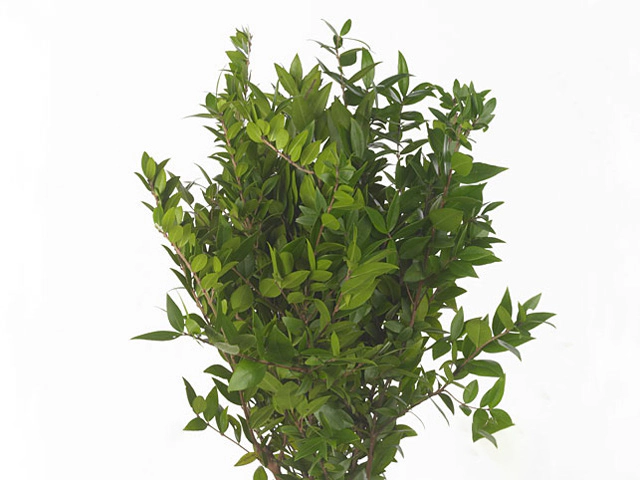Myrtus communis per bunch

| Leaf tip | Pointed/acute |
| Winter hardness | Limited (USDA-zone 8) |
| Flower color | White-white-155A |
| Leaf, general shape | Elongate |
| Leaf size | 4 - 5 cm |
| Light conditions | Sunny |
| Leaf, main color | Dark green |
| Toxicity (if consumed) | Not or barely |
| Moisture requirements | Well-drained |
Myrtle, scientifically known as Myrtus communis, is a popular evergreen shrub with various desirable characteristics. It is an attractive plant that can enhance the aesthetic appeal of gardens, parks, and landscapes.
One notable feature of Myrtle is its pointed or acute leaf tips, which give the plant a unique visual appeal. The leaves are elongate in shape and measure approximately 4-5 cm in size. They have a dark green color, making them visually striking against the backdrop of any garden.
When it comes to hardiness, Myrtle has limited winter tolerance and can survive in USDA zone 8. Therefore, it is important to consider the climatic conditions of the region before planting this particular shrub as it may not flourish in colder environments.
During the blooming season, Myrtle produces beautiful white flowers with a shade of white-white-155A. These delicate flowers add a touch of elegance to the plant, attracting pollinators like bees and butterflies to the garden. The fragrance emitted by the flowers is often considered soothing and refreshing.
One of the advantages of growing Myrtle is that it is not highly toxic when consumed. However, it is worth noting that it is still advisable to avoid ingesting the plant as it may cause slight discomfort or irritation, especially in individuals with sensitive digestive systems.
Myrtle thrives in sunny conditions and requires well-drained soil. It is important to ensure that the plant is exposed to adequate sunlight for optimal growth. Additionally, providing regular watering sessions while ensuring good drainage will help the plant flourish and maintain its health.
Whether used as a standalone shrub or in a mixed planting scheme, Myrtle can bring a touch of beauty to any garden. Its eye-catching foliage, elegant flowers, and low maintenance requirements make it an appealing choice for both novice and experienced gardeners. The plant's ability to withstand various weather conditions further adds to its desirability.
In conclusion, Myrtle (Myrtus communis) is a remarkable evergreen shrub with elongated, dark green leaves featuring pointed tips. With its limited winter hardiness, it thrives in USDA zone 8 and requires well-drained soil and sunny conditions. Producing beautiful white flowers with a soothing fragrance, Myrtle adds charm and elegance to gardens. While it has minimal toxicity when consumed, it is still recommended to avoid ingestion. Overall, Myrtle is an excellent choice for individuals seeking a striking, low-maintenance plant to enhance their outdoor spaces.
Market availability index by month:
| Jan. | Feb. | Mar. | Apr. | May | Jun. | Jul. | Aug. | Sep. | Oct. | Nov. | Dec. |
|---|---|---|---|---|---|---|---|---|---|---|---|
| 3 | 3 | 2 | 2 | 2 | 2 | 2 | 2 | 2 | 2 | 4 | 3 |